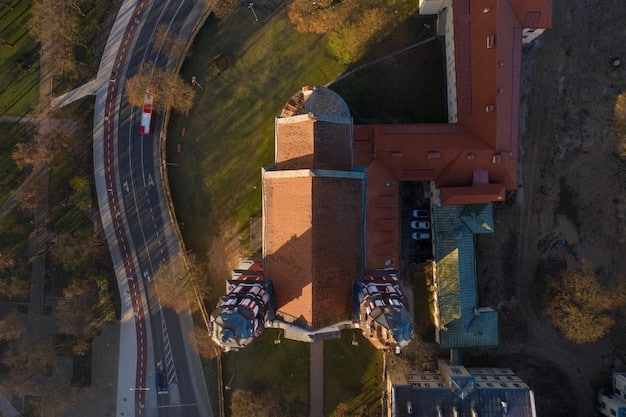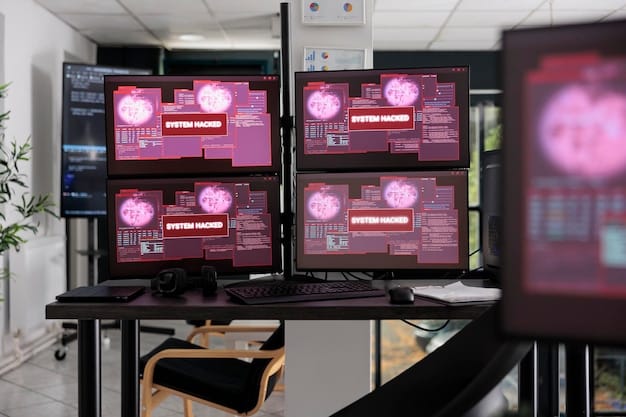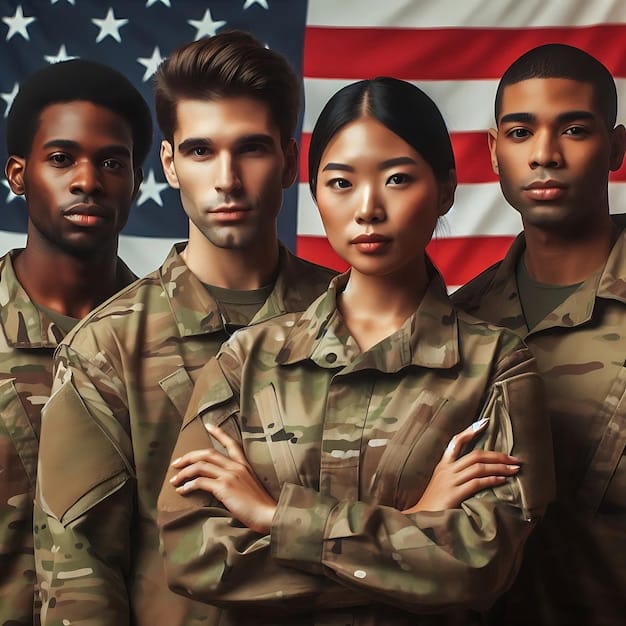The Future of NATO: US Influence on the Alliance’s Role

The Future of NATO: How is the US Shaping the Alliance in a Changing World? examines the evolving dynamics within the North Atlantic Treaty Organization, focusing on the United States’ significant influence in directing the alliance’s strategic priorities, adaptation to modern security challenges, and maintaining transatlantic unity in a shifting global landscape.
The **Future of NATO: How is the US Shaping the Alliance in a Changing World?** is a topic of immense importance. As geopolitical landscapes shift and new challenges emerge, the role of the United States within this alliance becomes increasingly vital.
The Historical Context of US Influence in NATO
The United States has been a cornerstone of the North Atlantic Treaty Organization (NATO) since its inception in 1949. Understanding the historical context of this influence is crucial to grasping the alliance’s present and future trajectory. From the Cold War era to the post-9/11 world, the US has consistently shaped NATO’s strategic direction.
Initially formed to counter Soviet expansion, NATO relied heavily on US military and economic might. The US commitment provided a security umbrella that allowed Western European nations to rebuild and develop. As the geopolitical landscape evolved, so did the nature of US influence within the alliance.
The US has historically provided significant funding, military resources, and leadership within NATO. This dominant role has not been without its challenges, with debates often arising over burden-sharing and the prioritization of strategic goals.
Key Periods of US Leadership
Throughout NATO’s history, certain periods have highlighted the extent and impact of US leadership, reflecting changing global dynamics and priorities.
- The Cold War Era: The US established NATO as a bulwark against Soviet aggression, providing nuclear deterrence and substantial conventional forces.
- Post-Cold War Adaptation: After the fall of the Soviet Union, the US guided NATO’s expansion and adaptation to new security challenges, including peacekeeping operations in the Balkans.
- The War on Terror: Following the 9/11 attacks, the US invoked Article 5, drawing NATO into operations in Afghanistan, marking a significant shift in the alliance’s focus.
- Current Geopolitical Realities: Today, the US is instrumental in shaping NATO’s response to Russian aggression, cyber warfare, and other emerging threats.
In conclusion, examining the historical context reveals the enduring and evolving nature of US influence within NATO, shaping its policies, strategies, and global role. US dominance has not been without its critics, the alliance has largely benefited because the US contributes more money than all of the other nations combined.
Modernizing NATO: US Priorities and Adaptations
In today’s rapidly evolving world, modernizing NATO is essential to address contemporary challenges. The United States plays a pivotal role in setting the modernization agenda, advocating for technological innovation, and promoting cyber defense capabilities.
The US priorities for modernizing NATO include enhancing its digital infrastructure, improving interoperability among member states, and investing in advanced military technologies. These adaptations are vital for maintaining NATO’s relevance and effectiveness in a complex security environment.
To keep pace with emerging threats and ensure that NATO remains a strong deterrent, the US has been at the forefront investing in cutting edge technologies to protect member countries.

Key Modernization Initiatives
Several modernization initiatives underscore the US commitment to enhancing NATO’s capabilities in the 21st century.
- Cyber Defense Enhancements: Strengthening NATO’s ability to defend against cyber attacks, including establishing rapid response teams and sharing threat intelligence.
- Technological Innovation: Promoting the adoption of artificial intelligence, autonomous systems, and other advanced technologies to maintain a military edge.
- Interoperability Improvements: Ensuring that NATO forces can operate seamlessly together through standardized equipment, training, and communication protocols.
- Space-Based Capabilities: Investing in satellite communications, surveillance, and navigation systems to enhance situational awareness and operational effectiveness.
In conclusion, the US is a driving force behind NATO’s modernization efforts, championing initiatives that enhance the alliance’s technological capabilities, cyber defenses, and overall readiness to meet contemporary security challenges.
The Economic Burden: US Contributions and Expectations
The economic dimension of US involvement in NATO is substantial, with the United States shouldering a significant portion of the alliance’s financial burden. This contribution has sparked debates about fair burden-sharing among member states and the expectations placed on European allies.
The US contributes the largest share to NATO’s direct and indirect funding, covering a significant percentage of the alliance’s overall budget. This financial commitment reflects the US role as a leading security provider within the transatlantic alliance, and it has allowed NATO to remain as relevant as it is today.
However, the US has consistently pushed for increased financial commitments from other member states, arguing that a more equitable distribution of the economic burden is essential for the long-term sustainability of the alliance. In response, European nations have gradually increased their defense spending in an effort to balance the overall requirements.
Perspectives on Burden-Sharing
Various perspectives exist regarding the optimal distribution of the economic burden within NATO, highlighting different priorities and strategic considerations.
- The US Perspective: Advocates for greater financial contributions from European allies, emphasizing the need for a more equitable distribution of defense spending relative to GDP.
- The European Perspective: Focuses on investments in specific capabilities and contributions to NATO missions, rather than solely on meeting arbitrary spending targets.
- The NATO Perspective: Stresses the importance of collective security and mutual support, encouraging member states to invest in areas that enhance the alliance’s overall effectiveness.
In conclusion, the economic burden of US involvement in NATO is an important aspect of the transatlantic relationship, influencing debates about burden-sharing, strategic priorities, and the long-term financial sustainability of the alliance.
Transatlantic Unity: Challenges and Opportunities
Maintaining transatlantic unity is a perennial challenge for NATO, requiring constant effort to bridge differing perspectives, address emerging security threats, and foster trust among member states. The role of the US in championing transatlantic solidarity is vital for NATO’s cohesion and effectiveness.
Various factors can strain transatlantic relations, including trade disputes, divergent foreign policy priorities, and disagreements over defense spending. However, the shared commitment to collective security and democratic values serves as a foundation for overcoming these challenges.
To strengthen transatlantic unity, the US can promote open dialogue, encourage collaboration on shared security interests, and reassure allies of its enduring commitment to NATO’s core principles.

Strategies for Strengthening Unity
Specific strategies can enhance transatlantic solidarity within NATO, fostering a more cohesive and effective alliance.
- Diplomatic Engagement: Promoting regular consultations and dialogue among member states to address concerns and build consensus on strategic priorities.
- Joint Exercises and Training: Conducting multinational military exercises to enhance interoperability and foster trust among NATO forces.
- Information Sharing: Enhancing the sharing of intelligence and threat assessments to improve situational awareness and coordinate responses to emerging threats.
In conclusion, transatlantic unity is essential for NATO’s strength and credibility, requiring sustained effort from the US and other member states to overcome challenges, foster trust, and promote shared security interests.
NATO and Global Conflicts: Adapting to New Threats
NATO’s role in addressing global conflicts is evolving as the alliance adapts to new threats and challenges in the 21st century. The US plays a key role in shaping NATO’s response to these conflicts, advocating for a comprehensive approach that combines military, diplomatic, and economic tools.
From counterterrorism operations to crisis management interventions, NATO has engaged in various global conflicts, often at the urging and with the support of the United States. These engagements reflect the alliance’s commitment to collective security and its willingness to project stability beyond its borders.
However, NATO’s involvement in global conflicts has also sparked debates about the scope and nature of its mission, the potential for overreach, and the need for greater coordination with other international actors.
NATO’s Evolving Role
NATO’s evolving role in global conflicts reflects changing geopolitical realities and strategic priorities.
- Counterterrorism Operations: Deploying forces to combat terrorist groups and disrupt their networks, particularly in regions where they pose a direct threat to member states.
- Cyber Warfare Defense: Developing capabilities to defend against cyber attacks and deter malicious actors from disrupting critical infrastructure or spreading disinformation.
- Hybrid Warfare Response: Countering hybrid threats that combine military, political, and informational tactics to destabilize governments or undermine democratic processes.
In conclusion, NATO’s adaptation to new threats and its evolving role in global conflicts are essential for maintaining its relevance and effectiveness in a complex and unpredictable world, with the US serving as a catalyst for strategic adaptation and operational readiness.
The Future of NATO: Scenarios and Challenges
The future of NATO is subject to various potential scenarios and challenges, ranging from geopolitical shifts to technological disruptions. How the US navigates these uncertainties will significantly impact the alliance’s long-term viability and effectiveness.
One possible scenario involves increased geopolitical competition, particularly with Russia and China, requiring NATO to bolster its deterrence capabilities and strengthen its presence in strategic regions. Another scenario entails the rise of non-state actors and transnational threats, necessitating greater cooperation on counterterrorism, cyber defense, and crisis management.
Addressing these challenges will require strategic foresight, adaptability, and a renewed commitment to transatlantic unity.
Future Scenarios for NATO
Exploring potential future scenarios can help NATO anticipate and prepare for various challenges and opportunities.
- Increased Geopolitical Competition: Bolstering deterrence capabilities and strengthening presence in strategic regions to counter potential aggression from rival powers.
- Transnational Threats: Enhancing cooperation on counterterrorism, cyber defense, and crisis management to address threats from non-state actors and transnational networks.
- Technological Disruptions: Adapting to the rapid pace of technological change and investing in advanced military capabilities to maintain a competitive edge.
In conclusion, the future of NATO will depend on its ability to adapt to evolving threats, navigate geopolitical uncertainties, and maintain transatlantic unity, with the US playing a critical role in shaping the alliance’s strategic direction and operational effectiveness.
| Key Point | Brief Description |
|---|---|
| 🛡️ US Influence | The US has historically shaped NATO’s strategies and priorities. |
| 🌐 Modernization | US leads in modernizing NATO for cyber defense and tech innovation. |
| 💰 Burden Sharing | US advocates for fair financial contributions from all members. |
| 🤝 Transatlantic Unity | Maintaining unity is crucial; US promotes dialogue and collaboration. |
FAQ
▼
Article 5 is a collective defense clause, stating that an attack against one member is considered an attack against all. It has been invoked only once, by the United States after the 9/11 attacks to show the support of partner countries.
▼
The US provides the largest share of direct and indirect funding to NATO. This includes contributions to NATO’s budget and investments in military capabilities that benefit the entire alliance, making them a key financial contributor.
▼
Trade disputes, differing foreign policy priorities, and disagreements over defense spending can strain transatlantic relations. That is why it is important for strong leadership to keep nations aligned in times of conflict.
▼
NATO is enhancing its cyber defense capabilities by establishing rapid response teams, sharing threat intelligence, and developing common standards for cyber security to counter cyber attacks efficiently.
▼
NATO engages in conflict management through military deployments, diplomatic efforts, and economic support. These efforts aim to stabilize regions, combat terrorism, and support international security initiatives as needed.
Conclusion
In conclusion, the US plays a pivotal role in shaping NATO’s future, influencing its modernization, financial stability, transatlantic unity, and adaptation to global conflicts. The alliance’s ongoing evolution depends significantly on how the US navigates emerging challenges and opportunities in the changing global landscape.





